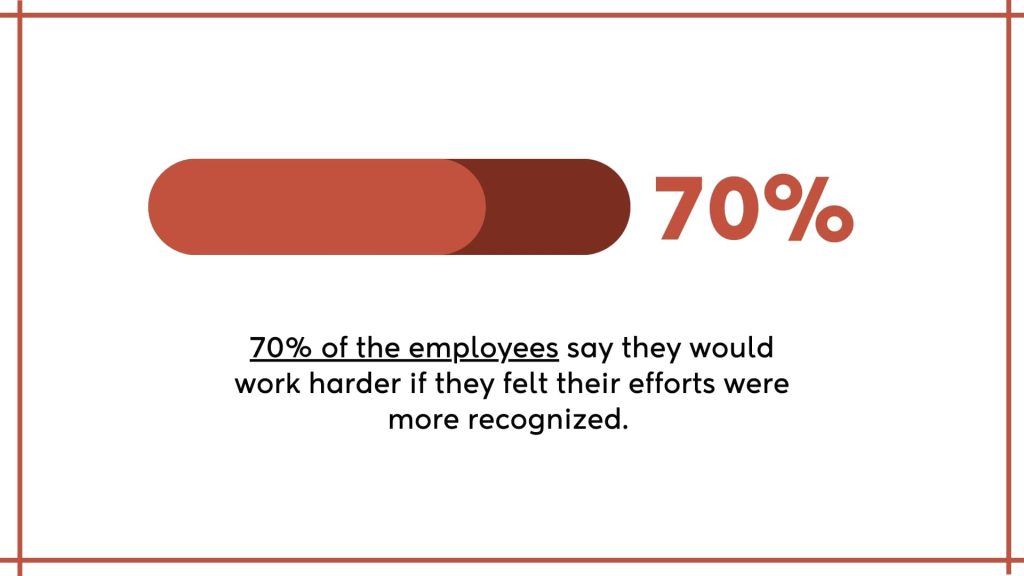Many of us equate the positive feedback with appreciation. But it is more than that — it is appreciation with context.
For example, if you keep saying to your employees “You are amazing” without providing further context as to why they are so. This will lead to two things: first, it makes your employees feel that you did not mean it genuinely, and second, it will undermine the power of your positive feedback.
Not everyone is an expert in giving positive feedback.
69% of the managers say they are uncomfortable communicating with employees. So, we need to learn how to give feedback.
In this post, we will look at some positive feedback examples to take inspiration on how to give positive feedback. We will also talk about the benefits of positive feedback.
What is positive feedback?
Positive feedback is an act of praising someone when you think one deserves the praise. Whether it is a well-completed project, exceptional performance, or someone exceeding expectations, positive feedback is essentially a way to appreciate the performance.
Why is it important to give positive feedback?
We tend to think when someone is doing well, one knows that they are doing well and there is no need for appreciation. It is when something is wrong we need to jump in.
But it is not so, we need positive feedback equally importantly as we need constructive feedback to make improvements.

The root of the positive effects of positive feedback lies in the theory of positive reinforcement. It talks about attaching a positive behavior to the reward to encourage it to repeat in the future.
Even if you do not want to go by theoretical explanations, as a human being, we all know we like genuine appreciation. It helps us improve our mood, boost morale, and encourage us to do better.
The benefits of providing positive feedback
Providing consistent positive feedback at the workplace offers numerous benefits. Have a look at some of the key benefits of positive feedback.
Build trust and better relationships
Positive feedback includes genuinely appreciating someone’s effort. It helps you build trust and create a comfort zone with employees to build better relationships.
Boost employee morale and motivation
When you recognize someone’s hard efforts, this boosts their morale and motivation, especially if it comes from someone higher in authority. Positive feedback encourages employees to perform better which results in improved performance.
Also read: 15 hacks that answer how to regain motivation at work
Increase job satisfaction
Positive feedback makes people feel appreciated and recognized. And when one is cherished for the hard work they are putting in, it helps increase job satisfaction and also reduce work burnout. This eventually results in increased retention as people enjoy working in your organization.
9 Positive feedback examples
Appreciating someone you have known for years is easier than someone you just built a working relationship with. Also, in a formal setting, not everyone is sure of what are the right words to use.
I understand it comes with time and experience but looking at real-life positive feedback examples can help you get started. Have a look at the top 9 positive feedback examples.
1. When someone did a good job
“I wanted to tell you that I am really happy with the way you performed in this task. I appreciate your quality of work and attention to detail. This is exactly how we would like to work. Thanks for your efforts!”
2. When someone is a team player
“I am really happy to see the way you help other team members in their work. It really helps build a bond between the team and work together successfully. These are the qualities we cherish in our team members. We are really thankful for you to contribute to make this workplace a better place.”
3. When someone is putting extra-efforts
“I have been noticing you putting in extra effort lately. Ideally, we would like to make sure that no one has to work extra hours. We are looking for new resources to shed some burden. Meanwhile, these extra efforts are really helping us stay on track. I am thankful for your hard efforts. Let me know if I can help you in some way to make things easy for you.”
4. When someone completes their goals
“I am happy to inform you that you have met all of the goals for this quarter. Your performance, hard work, and presence is a real asset for our team. It gives inspiration to others to do better. Thanks for your commitment. I wish you growth!”
5. When someone takes additional responsibilities
“Hi, team. I really wanted to shout out for David to take the additional responsibilities. Ideally, it was not his role to take care of content editing. Meanwhile, we are looking for a new content editor, he is taking care of the role very well. Thanks, David for stepping up. This has provided us with sufficient time to find a suitable candidate for the role without hampering our existing processes.”
6. When someone helps in conflict resolution
“I really appreciate the way you handled the situation today and brought both the marketing and content departments together on how to achieve the objective of the new marketing campaign. I know it takes a huge understanding to bring two perspectives together, but you handled it gracefully keeping both the parties happy. Thank you!”
7. When a new hire makes an impact
“I am just here to tell you that you are doing a great job. You are doing better than what we expect from a new hire. You are learning things quickly and bringing a fresh perspective to the table. Keep up the good work.”
8. When someone contributes with creative ideas in a meeting
“I really appreciate the points you brought to the meeting today. I welcome creative ideas. It helps us see things in a way we are not able to see. Thanks for your insights. And keep bringing such insights forward for collective improvement.”
9. When someone needs a morale boost
“I really appreciate the efforts you put into the project. Like everyone, you have been a crucial asset to the team and each member’s contribution is important for the success of the project. I admire your work and we all learn from one another. Feel free to share anything you have in the mind”
How to give positive feedback in the workplace?
Giving positive feedback is both an art and a mechanism. Not only do you need to follow the basics of sharing feedback right but also learn how to deliver the feedback. We have learned from positive feedback examples how one can deliver the feedback.
Now, let’s look at key basics that ensure you are giving feedback in the right manner.
Value-based feedback
To make feedback effective, the first and foremost thing you need to do is attach it to the outcome. It needs not to be a tangible outcome.
For example, it can be an intangible thing like attitude. Irrespective of the outcome, feedback should be supported with genuine reasons or business results.
Before giving the feedback, write down the why, when, and where of the act to make feedback genuine, specific, and valuable.
Timely feedback
Your new hire did a great job in the first month and you are telling him about it after 6 months in a bi-annual performance review meeting.
Well, this is not at all the right way to give positive feedback. Now, it has no power to make an impact. Your new hire might have even forgotten about that.
If you informed the new hire right when you noticed achievements, it would have a great impact. Deliver the feedback within the right time.
Combination of public and one-on-one feedback
The one-to-one method of delivering feedback is good for constructive feedback because people want to hide from embarrassment. But for positive feedback, delivering positive feedback in front of others is the best way because people like public appreciation. Try to deliver positive feedback in public.
Performance management tools can help you publicly reward and recognize employees. HR managers and team leads can use it to make company-wide and team-wide announcements. Getting public appreciation pays off for the hard work they are doing.
Give feedback frequently
According to the research conducted by academic Emily Heaphy and consultant Marcial Losada, the ideal praise-to-criticism ratio for high-performing teams was 5.6 (that is, nearly six positive comments for every negative one).
It means you need to give six positive feedbacks for every single negative feedback to create maximum impact.
Try to give feedback frequently. It need not always be a detailed formal interaction. You can simply praise someone during casual conversations that they are doing well.
The frequency of positive feedback varies from person to person. Some may need positive discussions three times a month while others may be good with a monthly discussion. You have to decide based on the person’s nature how much and when one needs feedback.
Conclusion
Positive feedback plays a more important role than most of us think. If you are giving only constructive feedback but not positive, your employees will start feeling that they are not good enough. It is because you are not cherishing their wins and only scanning for what someone is doing wrong. And this will eventually lead an employee to look for better opportunities where they feel valued. Thus, positive feedback is not about being nice; it is a necessity.
By learning the basics of how to give positive feedback and using the above positive feedback examples, you can give positive feedback to your employees that motivates your employees, increases job satisfaction, and helps them perform better.
Read more:
- How to create a positive work environment?
- Everything You Need To Know About Onboarding Remote Employees Easily (and effectively)
- Top 10 Ways to Avoid Getting Bored of Being a Project Manager
FAQs
What is the difference between negative and positive feedback?
Negative feedback talks about things that have gone wrong whereas positive feedback talks about things that are going good. Negative feedback opens the doors for improvement. That’s why it is called constructive feedback.
What is a positive feedback loop?
A positive feedback loop is a loop where the output of one feedback cycle is used as input for the next feedback cycle. It helps create an impact out of your feedback and ensures it adds value.
What is inspiring feedback?
Inspiring feedback drives future betterment. It can be positive or constructive, but the focus will be to drive improvements. It helps you make improvements and set the direction of the actions you need to take in the future.


















No Comments